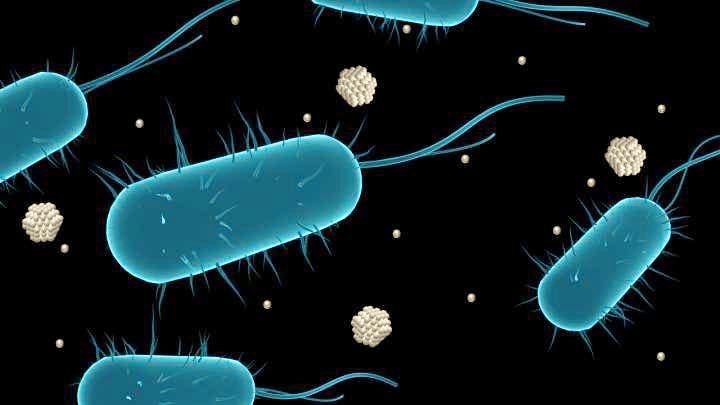Are silver nanoparticles a silver bullet against microbes?

A depiction of hyper-motile E.coli, a strain of bacteria found to resist silver nanoparticles' antimicrobial properties after repeated exposure.
Credit: Lisa Stabryla/University of Pittsburgh
Leanne Gilbertson’s group studies the mechanisms behind bacterial resistance to silver nanoparticles to determine if their ubiquitous use is a solution to the antimicrobial resistance challenge or if it is perhaps fueling the fire.
Antimicrobials are used to kill or slow the growth of bacteria, viruses and other microorganisms. They can be in the form of antibiotics, used to treat bodily infections, or as an additive or coating on commercial products used to keep germs at bay. These life-saving tools are essential to preventing and treating infections in humans, animals and plants, but they also pose a global threat to public health when microorganisms develop resistance to them, a concept known as antimicrobial resistance.
One of the main drivers of antimicrobial resistance is the misuse and overuse of antimicrobial agents, which includes silver nanoparticles, an advanced material with well-documented antimicrobial properties. It is increasingly used in commercial products that boast enhanced germ-killing performance – it has been woven into textiles, coated onto toothbrushes, and even mixed into cosmetics as a preservative.
The Gilbertson Group at the University of Pittsburgh Swanson School of Engineering used laboratory strains of E.coli to better understand bacterial resistance to silver nanoparticles and attempt to get ahead of the potential misuse of this material. The team recently published their results in Nature Nanotechnology.
“Bacterial resistance to silver nanoparticles is understudied, so our group looked at the mechanisms behind this event,” said Lisa Stabryla, lead author on the paper and a recent civil and environmental PhD graduate at Pitt. “This is a promising innovation to add to our arsenal of antimicrobials, but we need to consciously study it and perhaps regulate its use to avoid decreased efficacy like we’ve seen with some common antibiotics.”
Stabryla exposed E.coli to 20 consecutive days of silver nanoparticles and monitored bacterial growth over time. Nanoparticles are roughly 50 times smaller than a bacterium.
“In the beginning, bacteria could only survive at low concentrations of silver nanoparticles, but as the experiment continued, we found that they could survive at higher doses,” Stabryla noted. “Interestingly, we found that bacteria developed resistance to the silver nanoparticles but not their released silver ions alone.”
The group sequenced the genome of the E.coli that had been exposed to silver nanoparticles and found a mutation in a gene that corresponds to an efflux pump that pushes heavy metal ions out of the cell.
“It is possible that some form of silver is getting into the cell, and when it arrives, the cell mutates to quickly pump it out,” she added. “More work is needed to determine if researchers can perhaps overcome this mechanism of resistance through particle design.”
The group then studied two different types of E.coli: a hyper-motile strain that swims through its environment more quickly than normally motile bacteria and a non-motile strain that does not have physical means for moving around. They found that only the hyper-motile strain developed resistance.
“This finding could suggest that silver nanoparticles may be a good option to target certain types of bacteria, particularly non-motile strains,” Stabryla said.
In the end, bacteria will still find a way to evolve and evade antimicrobials. The hope is that an understanding of the mechanisms that lead to this evolution and a mindful use of new antimicrobials will lessen the impact of antimicrobial resistance.
“We are the first to look at bacterial motility effects on the ability to develop resistance to silver nanoparticles,” said Leanne Gilbertson, assistant professor of civil and environmental engineering at Pitt. “The observed difference is really interesting and merits further investigation to understand it and how to link the genetic response – the efflux pump regulation – to the bacteria’s ability to move in the system.
“The results are promising for being able to tune particle properties for a desired response, such as high efficacy while avoiding resistance.”
All latest news from the category: Life Sciences and Chemistry
Articles and reports from the Life Sciences and chemistry area deal with applied and basic research into modern biology, chemistry and human medicine.
Valuable information can be found on a range of life sciences fields including bacteriology, biochemistry, bionics, bioinformatics, biophysics, biotechnology, genetics, geobotany, human biology, marine biology, microbiology, molecular biology, cellular biology, zoology, bioinorganic chemistry, microchemistry and environmental chemistry.
Newest articles

Innovative 3D printed scaffolds offer new hope for bone healing
Researchers at the Institute for Bioengineering of Catalonia have developed novel 3D printed PLA-CaP scaffolds that promote blood vessel formation, ensuring better healing and regeneration of bone tissue. Bone is…

The surprising role of gut infection in Alzheimer’s disease
ASU- and Banner Alzheimer’s Institute-led study implicates link between a common virus and the disease, which travels from the gut to the brain and may be a target for antiviral…

Molecular gardening: New enzymes discovered for protein modification pruning
How deubiquitinases USP53 and USP54 cleave long polyubiquitin chains and how the former is linked to liver disease in children. Deubiquitinases (DUBs) are enzymes used by cells to trim protein…



